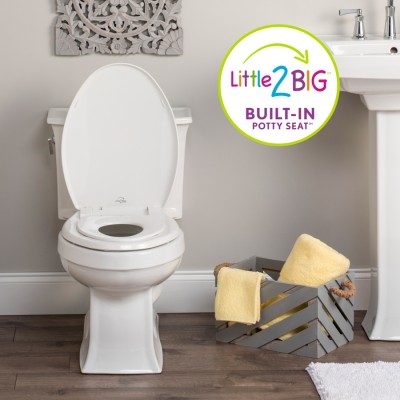When to Start Potty Training?
Five Steps to Tell If Your Child is Ready, How to Prepare & How to Create a Routine!
 It’s tempting to want to be finished with diapers, or to hope that maybe, just maybe, your toddler’s wish to wear “big kid” undies indicates that potty training success is imminent.
It’s tempting to want to be finished with diapers, or to hope that maybe, just maybe, your toddler’s wish to wear “big kid” undies indicates that potty training success is imminent.
Before you toss the diapers, though, consider that there is no “perfect” age to begin potty training. That’s because each child develops at her own rate and waiting until your daughter has reached certain developmental milestones makes the potty training process easier.
Five Signs for Potty Training Readiness in Toddlers
- A growing feeling of independence. This often shows as a desire to be a “big kid” or do “big kid” activities.
- The ability to keep his diaper dry for at least two hours.
- Communicating a need to “go” or hiding to go poop.
- Interest in the toilet or going to the bathroom.
- She can undress/dress herself in simple clothes and follow basic instructions.
 Five Steps to Prepare for Potty Training
Five Steps to Prepare for Potty Training
- Get a built-in potty training toilet seat. We recommend our NextStep2® or Little2Big™ built-in potty seats. Because they install directly on your toilet, they eliminate the hassle of emptying and sanitizing a stand-alone chair. Having our built-in potty seat on the toilet helps your toddler get used to seeing and using it.
- Teach him potty training words. Learning the vocabulary will help him better communicate when he has to use the toilet.
- Read books about potty training.
- Talk about the toilet and how it works. With your help, let him empty his dirty diaper into the toilet and flush so he understands the process.
- Consider if you'll be using rewards. Some children are motivated by them, while others aren't.
Five Steps to Create a Potty Training Routine
- Schedule potty breaks. Have your child sit on the potty seat without a diaper for a few minutes at two-hour intervals, as well as right away in the morning and before/after naps.
- Avoid questions that can be answered with a “no." For example, instead of asking, “Do you want to sit on the potty seat?” say, “It’s time to sit on the potty seat.”
- Dress him in clothes that are easy to remove. Elastic-waist pants make the last-minute dashes easier!
- Make sure her diet is high in fiber and liquids.
- If you haven’t already done so, begin teaching good hygiene.
What about nighttime? And accidents?
Relax – both are a normal part of potty training! In fact, some children aren’t fully nighttime trained for a couple years after potty training starts. And when accidents happen – and they will – don’t scold or shame your child. Instead, reassure her by saying, “Don’t worry. Next time you’ll get to the bathroom sooner.”
We have lots of helpful potty training articles in The Reading Room!